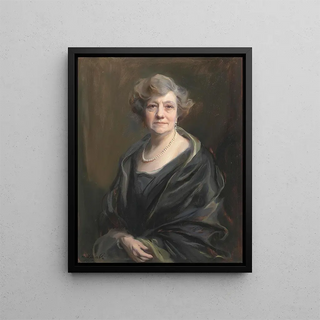Art print | Portrait of Jean Garmany Brandt - Philip Alexius de László


View from behind

Frame (optional)
In the fascinating world of painting, some artworks stand out for their ability to capture not only the physical appearance of a subject but also the very essence of their character. The "Portrait of Jean Garmany Brandt" by Philip Alexius de László is a perfect example. This piece, created in the early 20th century, demonstrates technical mastery and artistic sensitivity that go beyond a simple portrait. Through this representation, László invites the viewer to delve into the personal and social universe of his model, Jean Garmany Brandt, while offering a reflection on the era and environment in which he lived. The psychological depth and fine details make this portrait an essential piece, both for art enthusiasts and collectors.
Style and uniqueness of the work
Philip Alexius de László's style is characterized by impressive realism, where each brushstroke seems carefully thought out to pay homage to the personality of the subject. In the "Portrait of Jean Garmany Brandt," the artist manages to create an intimate atmosphere, almost tangible. The play of light and shadow, as well as the nuances of color, bring a lively dimension to the painting. László employs painting techniques that highlight the textures of clothing and the softness of the skin, creating a striking contrast between the neutral background and the central figure. This art print does not merely depict a man; it evokes a story, a life, a moment frozen in time. Brandt's posture, his penetrating gaze, and the expression on his face reveal a strong character and a complex personality, inviting the viewer to question his identity and journey.
The artist and his influence
Philip Alexius de László, a Hungarian-born portrait artist, established himself as one of the most prominent artists of his time. His career, marked by prestigious commissions and encounters with iconic figures of his era, testifies to his exceptional talent. Influenced by the great masters of the past, he developed a style that is uniquely his own, blending tradition and modernity.

Matte finish

View from behind

Frame (optional)
In the fascinating world of painting, some artworks stand out for their ability to capture not only the physical appearance of a subject but also the very essence of their character. The "Portrait of Jean Garmany Brandt" by Philip Alexius de László is a perfect example. This piece, created in the early 20th century, demonstrates technical mastery and artistic sensitivity that go beyond a simple portrait. Through this representation, László invites the viewer to delve into the personal and social universe of his model, Jean Garmany Brandt, while offering a reflection on the era and environment in which he lived. The psychological depth and fine details make this portrait an essential piece, both for art enthusiasts and collectors.
Style and uniqueness of the work
Philip Alexius de László's style is characterized by impressive realism, where each brushstroke seems carefully thought out to pay homage to the personality of the subject. In the "Portrait of Jean Garmany Brandt," the artist manages to create an intimate atmosphere, almost tangible. The play of light and shadow, as well as the nuances of color, bring a lively dimension to the painting. László employs painting techniques that highlight the textures of clothing and the softness of the skin, creating a striking contrast between the neutral background and the central figure. This art print does not merely depict a man; it evokes a story, a life, a moment frozen in time. Brandt's posture, his penetrating gaze, and the expression on his face reveal a strong character and a complex personality, inviting the viewer to question his identity and journey.
The artist and his influence
Philip Alexius de László, a Hungarian-born portrait artist, established himself as one of the most prominent artists of his time. His career, marked by prestigious commissions and encounters with iconic figures of his era, testifies to his exceptional talent. Influenced by the great masters of the past, he developed a style that is uniquely his own, blending tradition and modernity.






